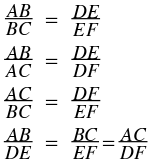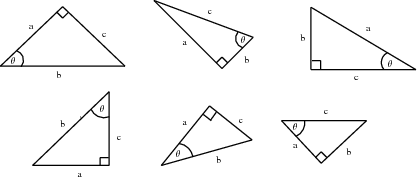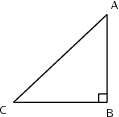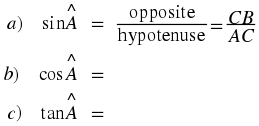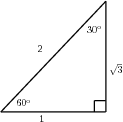Definition of the Trigonometric Functions
We are familiar with a function of the form
f(x) where
f
is the function and
x
is the argument. Examples are:
The basis of trigonometry are the trigonometric functions. There are three basic trigonometric functions:
These are abbreviated to:
These functions are defined from a right-angled triangle, a triangle where one internal angle is 90
∘ .
Consider a right-angled triangle.
In the right-angled triangle, we refer to the lengths of the three sides according to how they are placed in relation to the angle
θ
. The side opposite to the right angle is labelled the hypotenus, the side opposite
θ
is labelled opposite, the side next to
θ
is labelled adjacent. Note that the choice of non-90 degree internal angle is arbitrary. You can choose either internal angle and then define the adjacent and opposite sides accordingly. However, the hypotenuse remains the same regardless of which internal angle you are referring to.
We define the trigonometric functions, also known as trigonometric identities, as:
These functions relate the lengths of the sides of a right-angled triangle to its interior angles.
One way of remembering the definitions is to use the following mnemonic that is perhaps easier to remember:
Table 9.2. |
Silly Old Hens |

|
|
Cackle And Howl |

|
|
Till Old Age |

|
You may also hear people saying Soh Cah Toa. This is just another way to remember the trig functions.
Note
The definitions of opposite, adjacent and hypotenuse are only applicable when you are working with right-angled triangles! Always check to make sure your triangle has a right-angle before you use them, otherwise you will get the wrong answer. We will find ways of using our knowledge of right-angled triangles to deal with the trigonometry of non right-angled triangles in Grade 11.
Investigation : Definitions of Trigonometric Functions
In each of the following triangles, state whether
a
,
b
and
c
are the hypotenuse, opposite or adjacent sides of the triangle with respect to the marked angle.
Complete each of the following, the first has been done for you
Complete each of the following without a calculator:
For most angles
θ
, it is very difficult to calculate the values of sinθ
, cosθ
and tanθ
. One usually needs to use a calculator to do so. However, we saw in the above Activity that we could work these values out for some special angles. Some of these angles are listed in the table below, along with the values of the trigonometric functions at these angles. Remember that the lengths of the sides of a right angled triangle must obey Pythagoras' theorum. The square of the hypothenuse (side opposite the 90 degree angle) equals the sum of the squares of the two other sides.
Table 9.3. | |
0 ∘
|
30 ∘
|
45 ∘
|
60 ∘
|
90 ∘
|
180 ∘
|
|
cos
θ
| 1 |

|

|

| 0 |
–
1
|
|
sin
θ
| 0 |

|

|

| 1 | 0 |
|
tan
θ
| 0 |

| 1 |

|
–
| 0 |
These values are useful when asked to solve a problem involving trig functions without using a calculator.
Exercise 9.2.1. Finding Lengths (Go to Solution)
Find the length of x in the following triangle.





